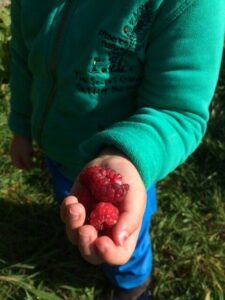
Lush and bountiful were the words that came to mind as we took temporary leave of our beloved woods for the summer break.
The bright watercolour leaves of spring had deepened to a richer palette with chlorophyll in strong evidence. Woodland plants growing side by side exuded a delicious cocktail of scent in the warmth of the sun, and for a few weeks the soundtrack of laughing children was swapped out for the soft hum of bees, the rustle of willow and vibrant, multivocal birdcall.
At the Secret Garden we are so fortunate to have the facilities for both cultivated and wild plant growth and appreciation. The children nurture their relationship with the natural world as they nurture the plants in our nursery garden, witnessing growth cycles, identifying species and whenever possible sampling edible varieties, each experience reinforcing that magical link between seed to soil to shoot to plant.
For children in the early years, the sensory experience of picking and eating food growing wild is a primal and powerful thing, lingers long in the memory and brings them real joy, and so if at all possible, this is something that we try to respect, educate on, responsibly encourage and not deny.
In a spirit of open communication, the children are supported to understand that any plant we forage must first be identified by an adult. Resources such as field guides and ID charts are provided to increase knowledge and inspire their interest, while certain things are left well alone. We never, for instance, pick mushrooms.
Aspiring to exist synergistically with the other life that calls the woods home, gentle yet consistent reminders to notice and appreciate the foraging habits of other creatures, as well as the needs of plants and trees, are a chance to communicate playfully as well as learn.
‘Do you think that ladybird might be about to eat their lunch?’
Our last few weeks were greatly enhanced with the foraging opportunities of the season, and the children loved literally seeing the fruits of all the gardening labours emerge in the strawberry patch and the blackcurrant bushes; particularly abundant this year.
Mint, lemon balm and fennel had been thriving thanks to the careful attentions of our gardener and herbalist dream team, keeping the younger fresh in breath and the older refreshed with fragrant infusions.
Elsewhere, the play spaces are awash! Amiable plantain, with little cheerful wands that can be steamed and eaten like a vegetable, and leaves that can be picked and thoroughly squashed release a juice that soothes nettle stings even more effectively than the traditional dock.
We also have a sizeable plantation of comfrey, another known for its healing properties. Historically used to treat wounds, comfrey can be mashed to a poultice and applied to sprains and breaks, and makes a great natural bandage.
Earlier in the year, the fresh, lemony tang of young beech leaves were enjoyed as we were on the move between play sites (is it a coincidence two of our stopping places are beech trees?) and wild garlic and raspberries were also in abundance.
More recently the Cleavers, (or Sticky Willy), reappeared to claim their annual crown of adhesive all-star, appropriately playing a starring role in the birthday crowns we make for the children.
These multifaceted marvels are a natural detoxifier and the freshly-picked leaves, rinsed well and left overnight in a jug of water, make a wonderful lymphatic tonic. Tasting vaguely herbal and grassy, its effects, it must be mentioned, are allegedly diuretic too.
Then once dried out, they can be used for lighting fires when the burrs have turned to brrrs….and they more or less gather themselves! Kitted out in natural fibres and in the excellent company of a Secret Gardener, I believe you will be able to make it home with a bunch entirely hands-free.
In the trees and hedgerows, the brambles and plums hold back until autumn, but the milky beechnuts are already falling and the waving cherries glow from a faint blush to magenta.
The season continues to turn like notches on a dimmer switch, moving through each subtle shade.
By Mazz Brown, with thanks to Anna Kinross for her kind contributions.
